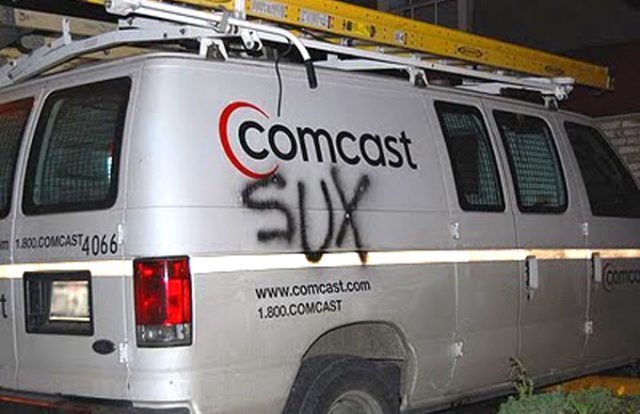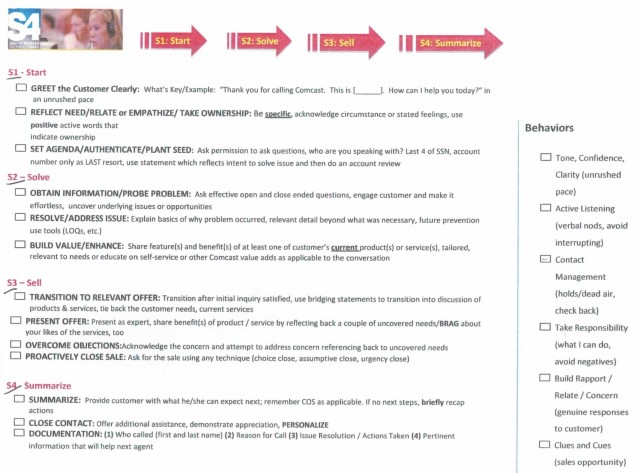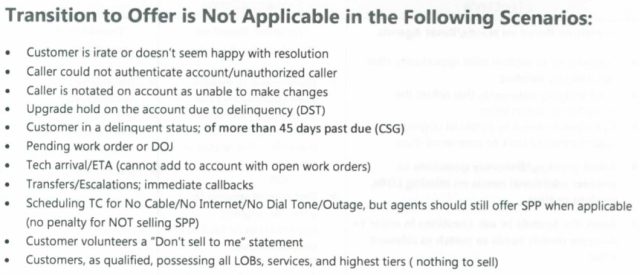
Media attention and fallout from Comcast’s viral customer service missteps continue to plague the country’s largest Internet service provider. First there was Ryan Block’s ludicrous cancellation call, then Comcast refused to refund invalid fees for Tim Davis until he caught the company in a lie, and then Comcast kept Aaron Spain on hold for three hours, long enough for the customer service lines to close and leave Spain in limbo.
Each instance has been met with a swift response from Comcast’s PR group after going viral, but quick, reactionary responses don’t do anything to fix the underlying problems. Leaked documents obtained by The Verge (full PDF) paint a portrait of exactly how broken things are in Comcast call centers throughout the country, and the documents confirm what current and former Comcast employees have been saying for the past few weeks: selling services is a required part of the job, even for employees doing tech support. Comcast did not immediately respond to our request for comment.
It’s all part of "S4," a "universal call flow" for Comcast call center employees. Those four letters stand for "start, solve, sell, and summarize."

"I don’t want any of our employees to feel that pressure to go through and sell… or feel like they’re going to get fired," Comcast SVP of Customer Experience Tom Karinshak previously told The Verge. Karinshak’s statement must be viewed through the lens provided by the S4 training material, which explicitly states that 20 percent of a call center employee’s rating for a given call is dependent on effectively selling the customer new Comcast services.
The language of the document is gussied up with MBA-friendly acronyms, and it reads like training material from any other sales-focused organization. There are pages of materials on "probing" customers to ferret out upsell opportunities, as well as on batting aside customer objections to being told they need to buy something. "We can certainly look at other options, but you would lose which you mentioned was important to you," the guide suggests clumsily saying to an angry customer who doesn’t want to buy any more Comcast services.

If Comcast had its way, each customer service call would play out like an elaborately choreographed dance, with the Comcast agent leading the customer through a series of steps designed to both fix the customer’s problems and extract additional revenue out of them. The call flow matrix instructs the agent to greet, empathize, and take ownership of the call; tellingly, although the "solve" portion of the call flow chart is weighted heavier than the "sell" portion (27 percent versus 20 percent), it contains fewer steps—and one of those steps is "Build Value/Enhance/Promote." Which, of course, is just a lead-up to selling.
On the back of a successful "solve" and with a supposedly grateful customer in hand, Comcast technicians are supposed to take what they’ve learned from being empathetic and "building value" to get the customer to buy some stuff. Notice the customer doesn’t have cable TV service? Pitch some service. Customer only likes Netflix? Pitch faster Internet service to make Netflix better. Customer doesn’t seem receptive to upselling? Ask if their spouse or kids or relatives like faster Internet and then sell on their behalf.There are a few things customers can do, per the document, to avoid the sales plays: one of them is to flat-out instruct the agent to not attempt to sell you services. "Customer volunteers a 'Don’t sell to me' statement" is explicitly listed under the section titled "Transition to Offer is Not Applicable in the Following Scenarios." Also free from the upsell treatment are customers who are delinquent on their bills, customers who are "irate," and customers who already own the highest tiers of service on every "LOB" (line of business) sold by Comcast.

The company’s choice to transform what is traditionally a non-revenue-generating area—customer service—into a revenue-generating one is playing out with almost hilariously Kafkaesque consequences. It is the nature of large corporations like Comcast to have dozens of layers of management through which leadership instructions and directives are filtered. The bigger the company, the more likely that members of senior leadership (like Tom Karinshak) typically make broad policy and leave specific implementations to lower levels. Here, what was likely praised in the boardroom as an "innovative" strategy to raise revenue is instead doing much to alienate customers and employees alike. Karinshak’s assurances that he doesn’t want employees to feel pressured to sell in spite of hard evidence that Comcast demands just that are hard to square with the content of the document.
Although Comcast’s executives are publicly quite sorry for the ongoing high-profile issues, and although the company has promised to review its procedures, the likelihood of real change seems small. In most of Comcast’s service areas in the United States, it is the only realistic option for low-latency, high-speed Internet access—and that means the next viral customer service debacle is just around the corner.
Update: Ars has spoken with Comcast, and a representative for the company confirmed that the training materials appear to be genuine, to the best of their knowledge. The representative also delivered the following statement:
Customer service is our number one priority. We have said that when our company has moments like these, we use them as an opportunity to get better, and we are doing that. We are changing our training programs, refreshing our managers on coaching for quality, and looking at our incentives to ensure we are rewarding employees for the right behaviors.
reader comments
199